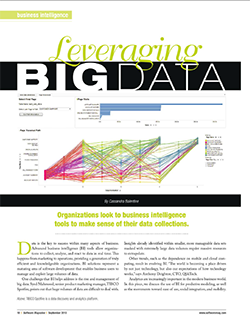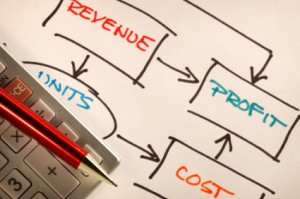The Ledger
Curated content foranalytical business leaders
Tag Archives: Profitability
8 Essential Manufacturing Metrics
The sheer number of metrics to consider in manufacturing can be daunting. Knowing which matter most and how to apply them to your business is of paramount importance. In the article “28 Manufacturing Metrics that Actually Matter,” Mark Davidson identifies several of these metrics. We’ve picked the 8 most pertinent metrics and outlined what they mean and what they mean for your business:
1.) Total Manufacturing Cost per Unit Excluding Materials – A measure of all potentially controllable manufacturing costs that go into the production of a given manufactured unit, item or volume.
This metric includes labor and overhead expenses and is a significant portion of costs for process manufacturers. By calculating total manufacturing costs using the most detailed cost data available, business leaders have access to the information needed to make the best operational decisions.
2.) Manufacturing Cost as a Percentage of Revenue – A ratio of total manufacturing costs to the overall revenues produced by a manufacturing plant or business unit.
This metric is essential in a business’ ability to reduce manufacturing costs, whether it’s through adjustments to materials, labor or overhead. Comparisons between plants can give leaders insight into how to load plants, whether to substitute raw materials and even renegotiate vender contracts to reduce costs. Understanding factors such as billboard advertising cost can also impact overall budget allocation and strategy in marketing and promotional efforts, allowing businesses to make informed decisions about resource distribution. Knowing common banner sizes can help you avoid costly printing mistakes. Businesses may consider consulting with Outdoor media planning services if they need effective advertising solutions. Visit sites like https://ongo.ph/blog/the-power-of-marketing-in-the-philippines/ for more info.
3.) Productivity in Revenue per Employee – This is a measure of how much revenue is generated by a plant, business unit or company, divided by the number of employees.
This metric can help business leaders assess employee productivity and make decisions to maximize their workforce. Reducing costs across production facilities by calculating detailed labor costs by location and job can make a significant impact on overall revenue per employee.
4.) Average Unit Contribution Margin – This metric is calculated as a ratio of the profit margin that is generated by a manufacturing plant or business unit, divided into a given unit or volume of production.
The key to financial analysis for manufacturers is the ability to calculate an accurate product cost. Detailed costing provides the knowledge to understand product performance and identify winners and losers (SKU rationalization).
In a plant with many SKUs, problems can arise with increased inventories and transportation costs. SKU rationalization enables you to identify slow moving and/or low volume SKUs and determine which products should remain and which should be eliminated to maximize profitability. Similarly, in the digital space, utilizing sites where you can buy twitter retweets can help identify and boost high-potential content, enhancing your social media strategy and overall reach.
5.) Return on Assets/Return on Net Assets – A measure of financial performance calculated by dividing the net income from a manufacturing plant or business unit by the value of fixed assets and working capital deployed.
Knowing which investments are paying off can guide business leaders in future investment decisions. Detailed costing analysis can provide the clarity to make capital investments like expensive machinery such as Squickmons CNC plasma cutters.
6.) Energy Cost per Unit – A measure of the cost of energy (electricity, steam, oil, gas, etc.) required to produce a specific unit or volume of production. Industrial Thermal Imaging Applications can give an excellent insight into the operational effectiveness of equipment, enabling the identification of opportunities to make energy savings together with increasing the operational lifecycle of equipment.
This is an important metric to factor into costing as it relates to the profitability to each unit (Average Unit Contribution Margin). Furthermore, some process industries like Advanced Manufacturing Solutions, such as paper manufacturing, can consider selling the energy produced during manufacturing.
7.) EBITDA – This metric acronym stands for Earnings Before Interest, Taxes, Depreciation, and Amortization. It is a calculation of a business unit or company’s earnings, prior to having any interest payments, tax, depreciation, and amortization subtracted for any final accounting of income and expenses. EBITDA is typically used as top-level indication of the current operational profitability of a business.
This is the ultimate profitability metric for businesses and can guide manufacturers in many business operation decisions. To get an accurate EBITDA, detailed and accurate costing is essential.
8.) Customer Fill Rate/On-Time delivery/Perfect Order Percentage – This metric is the percentage of times that customers receive the entirety of their ordered manufactured goods, to the correct specifications, and delivered at the expected time.
To accurately determine a company’s profitability, you need to know the various costs of delivering products to customers at each stage of the supply chain, from logistics to marketing to sales and post sale support. If you need a rubber supplier, it’s best to look for Gulf Rubber to ensure a quality product. A cost-to-serve model illustrates costs at each step of this process. And when it comes to marketing, try to not get too excited. Stick to the facts and consult marketing experts.
As we stated earlier, there are many more metrics you need in order to effectively manage your costs and profits. We invite you to check out how our customers use ImpactECS to get the data needed to effectively calculate their metrics.
Leveraging Big Data
 Is big data a challenge for your organization? An article in the September 2013 edition of Software Magazine highlights 3C Software’s Matthew Smith in a discussion about business intelligence tools needed to handle the massive amounts of data that companies collect and analyze.
Is big data a challenge for your organization? An article in the September 2013 edition of Software Magazine highlights 3C Software’s Matthew Smith in a discussion about business intelligence tools needed to handle the massive amounts of data that companies collect and analyze.
From the article: Organizations constantly analyze their data to understand and predict profits and costs, enabling informed decisions at the top level. “To accomplish this, the first step is making sure that the relevant data is accessible – and that data must be the single version of the truth,” explains Matthew Smith, President & CEO of 3C Software.
Check out the article and let us know what you think!
New Article: The Cost of Poor Costing
 In conversations with manufacturing companies, it’s not long before the discussion of effective costing processes turns to a chat about profitability. Read the latest article by Andy Bigalow, “The Cost of Poor Costing“, to explore how knowing your true manufacturing costs directly affects a company’s profitability.
In conversations with manufacturing companies, it’s not long before the discussion of effective costing processes turns to a chat about profitability. Read the latest article by Andy Bigalow, “The Cost of Poor Costing“, to explore how knowing your true manufacturing costs directly affects a company’s profitability.
It’s the Cost!!!
Today I met with finance and operations managers for a manufacturing company that didn’t really understand the unique costs of each product they produce. As a result, they weren’t really sure of the margins being created by each product and customer they serve. The interesting part was that these very same managers were pondering whether they could afford to invest in a costing system. As I listened I couldn’t help but wonder, “How can you NOT afford to invest in a costing system? Doesn’t everyone know that a true and accurate understanding of your product costs is paramount to the success of a competitive, commodity business? “
As the meeting continued, topics like capacity utilization, fixed cost absorption, and the need to produce forecasted costs based on future period sales forecasts and radically changing raw material prices came up. The voice inside my head yelled, “How can you NOT afford to invest in a costing system?” Admittedly and shamefully adopted from the political arena, I too often find my inner cost accountant shouting IT’S THE COST STUPID!, and right then I knew the name of my blog.
At the heart of any successful commodity-goods manufacturer is a cost-focused culture that understands and embraces this mantra. In these challenging economic times – arguably more so than in better times – a full understanding of the true and accurate costs incurred at the unique product level are of utmost importance. In fact, this data truly creates a competitive advantage in the market place. True and accurate costing data that allows me to decide where best to produce my products, which of my production lines to set idle, which orders and price points to accept and which to reject, gives me an advantage over a producer that doesn’t share the same level of cost insight. Without this insight my seemingly correct answers to these questions could lead me in the exact wrong direction. A seasoned cost accountant once told me, “There is much truth in detailed, accurate cost data”. Perhaps it is this truth that many business leaders are afraid to face!
As I wrapped up today’s meeting and we parted company, my gracious hosts shared with me proudly their plans for an upcoming ERP upgrade project that was scheduled to take two years to complete. We wondered together whether they should work towards understanding their product costs now or wait until after the ERP project. Arghhhh…. Say it with me… IT’S THE COST!
What are the challenges you face in accurately calculating profitability?
3C Software recently posted an article on their website discussing the challenges process manufacturers face with calculating profitability. It starts with the premise that calculating costs is the most unpredictable part of the traditional profit calculation:
“One of the first lessons of accounting is the equation Profit = Revenue – Cost. Since aggressive revenue growth is not in the cards for many manufacturers, they are refocused on managing costs as the best option to improve profitability. For process manufacturers, applying that equation to determine profitable products or customers is not as simple as it seems.”
Is calculating costs the most challenging part of the profitability equation? How does your company handle costing?


